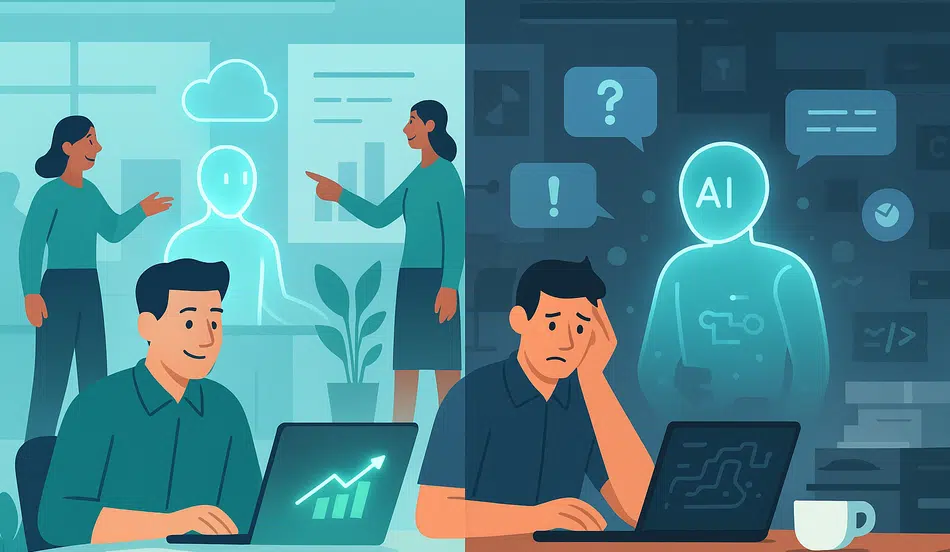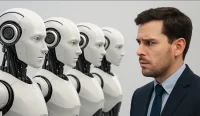The world is entering a period of exponential technological change, a transformation some analysts compare to the industrial revolutions that reshaped economies in the 18th and 19th centuries. Today, the catalyst is artificial intelligence — not just the chatbots that can answer questions or draft emails, but a new wave of so-called agentic AI.
These systems are designed to act more like digital colleagues than passive assistants. Instead of waiting for a prompt and delivering a single reply, they can take on multi-step projects, move between platforms, and even make decisions with minimal human supervision. Supporters believe they will revolutionize how work gets done, freeing employees from repetitive tasks and enabling new levels of creativity. Critics, however, warn that the technology is far from ready and may be more marketing spin than genuine revolution.
The debate is only just beginning, but with billions of dollars already invested, the race to build agentic AI systems is intensifying — and workplaces worldwide are bracing for impact.
What Is Agentic AI?
The term “agentic AI” refers to AI agents that operate autonomously. Unlike traditional chatbots, which rely on humans to provide precise prompts, agents are given broad objectives. They can then pursue those goals across multiple platforms until the task is completed.
Think of it as winding up a toy and letting it run. Once given access to documents, email, calendars, and enterprise software, an agent could — in theory — schedule meetings, approve expenses, draft reports, onboard employees, or interact with customers without ongoing supervision.
In July, OpenAI unveiled its ChatGPT “agents” capability, promising integration with workplace calendars and task managers. Microsoft, meanwhile, has been embedding AI functions into its productivity suite through Copilot, part of its broader push to help companies transition to AI-driven workflows.
“We’re still in the early innings,” said Colette Stallbaumer, general manager of Microsoft 365 Copilot, at a recent FT Women in Business summit. “If you haven’t started yet, you’re already behind.”
The Case for Optimism
Advocates argue that agentic AI could do for work what the assembly line once did for manufacturing: eliminate drudgery and make people more productive.
Zig Serafin, CEO of U.S.-based Qualtrics, envisions a future where employees focus on the uniquely human aspects of work — creativity, judgment, and emotional connection. “If people can spend more time on things that are more human, that improves the organisation’s ability to innovate,” he said.
Research firms see adoption climbing fast. Gartner recently surveyed more than 3,000 executives, nearly half of whom said they plan to invest in agentic AI cautiously but steadily. The technology’s supporters point to early pilots in areas such as customer service, recruitment, and expense management as evidence of its potential.
Some optimists even imagine “one-person unicorns” — entrepreneurs who, with the help of sophisticated AI agents, could build billion-dollar businesses without large staffs.
A Reality Check
Despite the hype, experts caution that the reality of agentic AI is far less polished than the promotional pitches suggest.
Melissa Heikkilä, the Financial Times’ AI correspondent, warns that companies may be rushing to adopt AI out of fear of missing out. “Billions, if not trillions, have been invested in this technology. But the big question remains: what is the killer app? What is this technology actually useful for? And we don’t really know that yet,” she said.
One key problem is reliability. Large language models, the foundation of most agentic AI tools, often generate plausible-sounding but incorrect outputs. Left to run autonomously, these errors can compound, leading to costly mistakes.
There is also the issue of “agentic washing” — when companies market standard AI products as autonomous agents to justify higher prices. Analysts note that truly independent AI, capable of completing complex, multi-step tasks without human correction, does not yet exist.
Trust and Transparency
Trust may prove the defining challenge of agentic AI. Rachel Botsman, a trust researcher and author, describes the coming shift as a “trust leap.” Humans are hardwired to resist unfamiliar systems, she argues, especially when asked to delegate sensitive responsibilities.
“My fear is not a lack of trust,” Botsman said. “It’s misplaced trust — believing the system is more capable or more aligned with human values than it really is.”
Unlike previous workplace tools, agents blur the boundary between human and machine decision-making. When an agent approves an expense or makes a hiring recommendation, employees may not know whether the decision was guided by human oversight or machine logic. That ambiguity could create friction inside organisations and even lead to legal or ethical disputes.
The Economic Backdrop
Behind the hype is a sobering financial reality. AI companies are spending vast sums to pursue artificial general intelligence (AGI) — systems that can match or exceed human intelligence across fields. Research and development budgets run into the billions, but revenue streams are far smaller.
For many firms, selling agentic AI services is as much about experimenting with revenue models as delivering immediate workplace value. “We are definitely the guinea pigs,” said one industry analyst.
This dynamic raises the stakes for early adopters. By experimenting with agentic systems, businesses may gain a competitive edge — or they may find themselves shouldering the costs of half-baked products.
Impact on Work and the Org Chart
If agents succeed, the traditional company hierarchy could be reshaped. Instead of humans filling every box in an org chart, some roles could be performed by AI systems working alongside human colleagues.
This might flatten organisations, reduce administrative layers, and accelerate decision-making. But it also raises difficult questions: How do you measure the performance of an AI colleague? Who is accountable for its mistakes? And how will humans adapt to working alongside autonomous digital entities?
The answers will shape not only productivity but also company culture. “Organisations will become less rigid,” said Serafin. “The lines between what humans do and what machines do will keep shifting.”
Jobs at Risk — and Jobs Reimagined
The most immediate concern is employment. Routine office roles — administrative assistants, junior analysts, and entry-level support staff — are particularly vulnerable. Analysts note that these are often the very roles that provide a pipeline for future managers, raising fears of long-term talent gaps.
At the same time, new roles are likely to emerge. Companies will need AI supervisors, ethics officers, and integration specialists. The challenge will be ensuring displaced workers can transition into these higher-skill positions.
Despite predictions of widespread automation, many experts insist humans remain essential. Large language models excel at producing average outputs — the most statistically likely next word in a sentence — but struggle with true originality. “If you want real genius or really good quality, you still need a human,” said one researcher.
Transition Into the Jobs of Tomorrow
Search WhatJobs for opportunities in AI supervision, ethics, integration, and more—helping you move beyond vulnerable roles into future-proof careers.
Search Jobs Now →Risks Beyond the Workplace
Beyond jobs, there are broader risks. Agents rely on vast amounts of data, raising concerns about privacy and security. If they are given access to calendars, communications, and financial systems, companies must ensure those systems are protected from leaks or misuse.
There is also the risk of over-dependence. Just as earlier generations of workers learned to rely on spreadsheets or search engines, tomorrow’s employees may lean heavily on agents. But if the systems fail — or produce flawed outputs — the consequences could ripple quickly through organisations.
Outlook: Promise, Peril, and Patience
The truth about agentic AI likely lies somewhere between utopia and dystopia. Fully autonomous systems are still years away, if not decades. Today’s tools remain experimental, prone to errors, and heavily reliant on human oversight.
But the direction of travel is clear. AI is moving from the margins of the workplace to the center. Leaders must prepare, not just by investing in technology, but by rethinking how trust, accountability, and creativity will function in a hybrid human–machine workforce.
As Botsman put it: “This is the first time in history that the line between human trust and technological trust is not even blurred — it’s undefined. We don’t know where it begins and ends.”
FAQs on Agentic AI
1. How is agentic AI different from chatbots like ChatGPT?
Traditional chatbots answer isolated queries. Agentic AI is designed to take on broader goals — such as onboarding an employee or managing a project — by moving across platforms and making decisions with minimal human input.
2. What industries are most likely to adopt agentic AI first?
Customer support, HR, and back-office administration are early targets, as these involve repetitive, rules-based processes. Finance, legal services, and marketing are also experimenting with AI agents.
3. Could agentic AI replace human managers?
Analysts believe AI may take over certain managerial functions — such as scheduling, reporting, and compliance — but human leaders will remain essential for strategy, judgment, and people management.
4. What are the biggest risks of agentic AI?
Key risks include data privacy breaches, misplaced trust in flawed outputs, job displacement, and over-reliance on untested systems. There is also concern about “agentic washing” — exaggerated marketing claims that overstate capabilities.
5. Will agentic AI lead to mass unemployment?
Experts are divided. Some predict large-scale displacement of entry-level roles, while others argue AI will complement rather than replace most jobs. The consensus is that new roles will emerge, but significant retraining will be required.
6. When will fully autonomous AI agents become a reality?
No timeline is certain. Current systems remain experimental and error-prone. While prototypes exist, analysts say we are still years away from true autonomy in complex business contexts.




